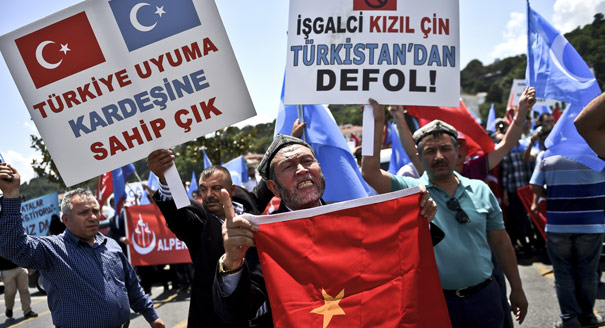In July, the Turkestan Islamic Party (TIP), which includes thousands of Uyghur fighters from China’s western Xinjiang province, paraded in Jisr al-Shughour, a strategic Syrian town in Idlib governorate.
To the astonishment of locals, a drone hovered over the speeding cars and filmed the procession. Dozens of military vehicles drove down the town’s main street as fighters waved flags, fired automatic weapons, and chanted Islamic slogans in Arabic. This show of force led Arab news media outlets to describe the event as the group’s takeover of Jisr al-Shughour, accompanied by the withdrawal of Hay’at Tahrir al-Sham, formerly Jabhat al-Nusra, the Syrian affiliate of Al-Qaeda that controls much of Idlib governorate.
However, locals in the town denied that it constituted a takeover. TIP has had a military presence in Jisr al-Shughour since 2015, and continues to operate closely with Hay’at Tahrir al-Sham. In fact, the latter nurtured and guided the group upon its arrival in Idlib, settling them in vacant towns whose populations, mostly Christians and Alawis, had fled.
For the inhabitants of Jisr al-Shughour, what characterizes the Uyghurs is their general indifference to measures such as imposing Sharia law and collecting taxes. “They built a reputation for minding their own business,” one Idlib resident told me. As a result of this, he continued, they are “more acceptable to locals than the North African jihadis,” who are notorious for their strict methods in dealing with civilian populations.
TIP’s interaction with civilians has been limited to the distribution of its Arabic-language magazine, Turkestan al-Islamiyya (Islamic Turkestan). The principal aim of the publication is to highlight China’s crackdown on Uyghur dissidents in Xinjiang and beyond, as well as Beijing’s policies of enforced assimilation. The magazine was launched in 2008 and has published 21 issues until now.
In addition to stories on TIP’s “martyrs” and articles on jihad, the magazine mostly focuses on Xinjiang, known in TIP’s terminology as Eastern Turkestan. Stories cover both the region’s history and current news of the struggle against the Chinese government. This territorial and ethnic commitment distinguishes TIP from Hay’at Tahrir al-Sham, as the Uyghurs share neither the divisive policies of Al-Qaeda and the Islamic State nor their disdain for modern national politics and history. Even their involvement in the fight against the Syrian regime is often framed as one directed against a Chinese ally in the region. Their motto, as stated in Turkestan al-Islamiyya, identifies TIP as “a group of Islam’s servants and mujahedeen for the sake of God, working to free Eastern Turkestan.”
Another trait of the group noticed by locals is their “Turkishness.” The deployment of TIP in border areas has driven suspicions of some form of collaboration with Turkey. The main contention of inhabitants of the region is that the Uyghurs entered Syria after Turkish border restrictions were already in place. However, this relationship is difficult to confirm.
Solidarity with the Uyghur struggle against Chinese assimilation has long been a part of domestic Turkish politics. That explains the large number of Uyghurs in Turkey, estimated at some 50,000 people. However, following the death in 1995 of Isa Yusuf Alptekin, an esteemed Uyghur dissident then living in Turkey, this support waned as Sino-Turkish ties improved. Instead, Germany became the primary destination for Uyghur activists. In 1995, an emerging figure in Turkish politics underlined his own absolute commitment to the Uyghur cause. Recep Tayyip Erdogan, then the mayor of Istanbul, named a section of the Sultan Ahmed mosque in the city for Alptekin, and declared:
Eastern Turkestan is not only the home of the Turkic peoples, it is also the cradle of Turkic history, civilization, and culture. To forget this would lead to the ignorance of our own history, civilization, and culture… The martyrs of Eastern Turkestan are our martyrs… Today the culture of the people of Eastern Turkestan is being systematically Sinicized.
Erdogan’s sympathy for the Uyghur nationalists became more nuanced under his premiership, as he sought a stronger economic relationship with Beijing. Maintaining that balance has proven difficult, however. Erdogan has seemed more likely to crack down on secular Uyghur nationalists than on the religious groups. This was the case when Turkey arrested and put on trial Abduqadir Yapchan of the World Uyghur Congress (WUC). Rabiya Kadeer, the iconic female leader of the WUC, criticized the Turkish move and expressed her concern that Ankara might reverse its century-old commitment to protecting the Uyghurs.
However, this has not been the case with the thousands of TIP militants. Their deployment near the Turkish-Syrian border suggests logistical help on the Turkish side, at least in terms of fresh recruits, which are needed given the group’s heavy losses during its two years of fighting. What’s next for the group and its highly trained fighters is unclear, although TIP’s alleged involvement in the bombing of the Chinese embassy in the Kyrgyz capital, Bishkek, last year could suggest a possible future path.
Inside Syria, the perceived Turkishness of these noninterfering jihadis is felt strongly by the displaced inhabitants of the small towns near Jisr al-Shughour. Among them are Armenians, Orthodox Christians, and Latin Catholics, many proud of their towns’ Byzantine heritage, such as the original inhabitants of Al-Ghassaniyya. To them, TIP’s presence in their towns and villages is highly symbolic. “The Ottomans want to return,” one former resident told me recently. However, the Uyghurs’ behavior suggests that their aspirations remain firmly anchored in Xinjiang.








